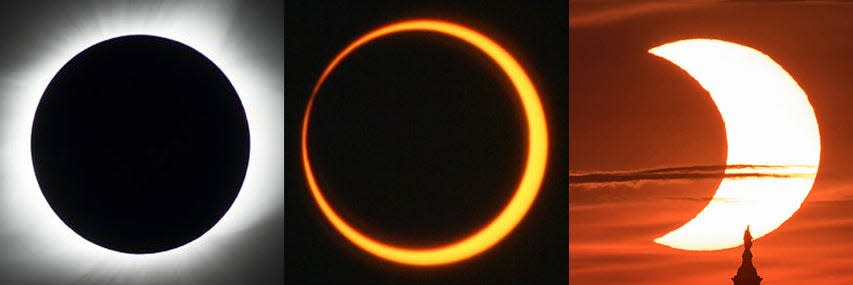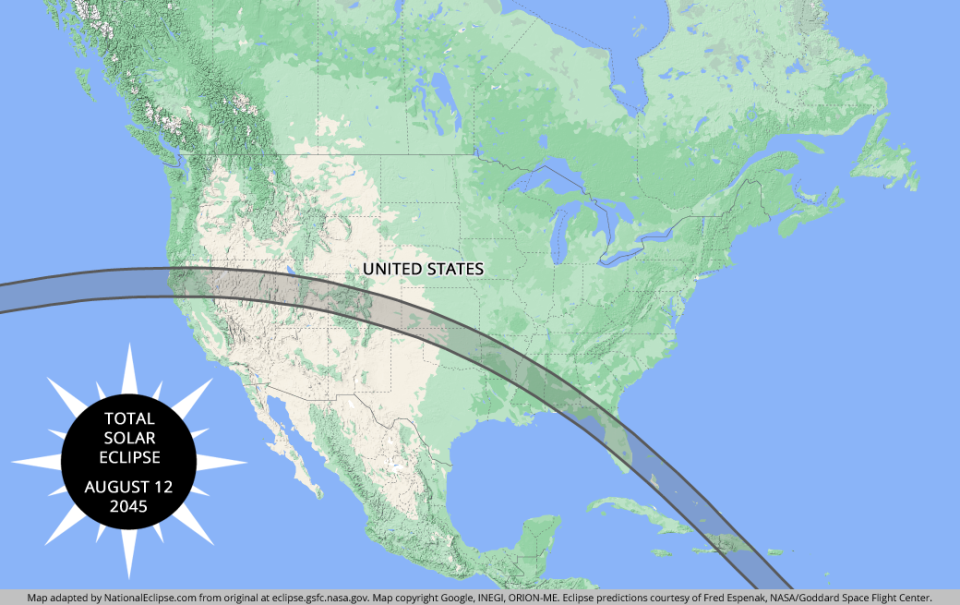Solar eclipse: What time, what will I see? Answers to 10 of the most common questions
We're at one week to go for the 2024 solar eclipse.
While Florida isn't in the path of totality, meaning we won't see the moon completely block the sun, depending on where you are in the state, anywhere from 52 percent to 84 of the sun will disappear behind the moon.
Here are the most googled questions about the eclipse being asked today by those in Florida.
What day is the solar eclipse?
The solar eclipse will take place April 8.
Warby Parker eclipse glasses
Warby Parker is offering free eclipse glasses at any of its locations starting today, Monday, April 1, while supplies last.
For the last week, the company has been promoting the glasses offer with short videos posted to social media of a woman in very Bella Baxter-like clothing (and eclipse glasses), lurching about in wonderment and looking up into the sky at a total eclipse, over a quote from the movie and haunting piano music.
Bella Baxter was in the award-winning 2023 movie "Poor Things."
Total solar eclipse 2024 path
In the United States, April's total solar eclipse will cross 13 states. Florida is not included.
Texas, Oklahoma, Arkansas, Missouri, Illinois, Kentucky, Indiana, Ohio, Pennsylvania, New York, Vermont, New Hampshire and Maine, plus parts of Tennessee and Michigan, are all in the 115-mile-wide path of totality.
To see the exact path of totality, check out an interactive map created by French eclipse expert Xavier Jubier.
What is an eclipse?

There are two types: lunar and solar.
During a lunar eclipse, the earth's shadow obscures the moon.
During a solar eclipse, the moon passes between the sun and the earth, said NASA.
There are four types of solar eclipses: total, annular, partial and hybrid.
Total solar eclipse: A total solar eclipse happens when the moon passes between the sun and earth, completely blocking the face of the sun, according to NASA.
Annular solar eclipse: This happens when the moon passes between the sun and earth, but when it is at or near its farthest point from earth. Because its farther away, the moon won't completely block the sun.
Partial solar eclipse: This happens when the moon passes between the sun and earth but the three are not lined up perfectly, so only a part of the sun will appear to be covered, giving it a crescent shape.
Hybrid solar eclipse: Because earth's surface is curved, sometimes an eclipse can shift between annular and total as the moon’s shadow moves across the globe.
Time to see peak solar eclipse in Florida
While Florida isn't in the path of totality, residents will be able to see a partial eclipse. Here's when you can watch the eclipse in any Florida location.
Depending on where you are in the Sunshine State, the moon will block anywhere from 54 percent to 82 percent of the sun. Residents in the northwest corner of the state will see more of the eclipse.
Click on your location in the map to see what percentage of the sun will be covered, when the peak time will be and the latest weather forecast when it comes to whether there will be clear skies on April 8.
Can't see the map? Open in a new browser.
➤ See exact times to go outside to see the eclipse across Florida
Solar eclipse path, times: Enter your zip code to see when the eclipse starts, peak coverage, when it ends
Can't see our graphics? Click here to reload the page.
Countdown clock to 2024 solar eclipse
How much of the 2024 solar eclipse will be visible in Florida?
Florida is not in the path of totality for April's solar eclipse. That means the moon won't totally block the sun.
Depending on where you are in the Sunshine State, the moon will block anywhere from 54 percent to 82 percent of the sun. Residents in the northwest corner of the state will see more of the eclipse.
Pineville, in the northwestern tip of Florida's Panhandle, is the city in Florida where the greatest percentage of the sun will be covered during the eclipse, according to Eclipse2024.
At the midpoint of the eclipse, Pineville viewers will see 82.4 percent of the sun covered at 1:55 .m. CDT, closely followed by Bratt with 82.3 percent of the sun blocked by the moon.
How often is there a solar eclipse?
On average, a total solar eclipse is visible from somewhere on earth every 18 months, according to Space.com.
When will Florida see a total solar eclipse?

Almost all of Florida will be in the path of totality for a total solar eclipse coming in 2045.
On Aug. 12, 2045, a total solar eclipse will be visible over almost all of Florida, according to NationalEclipse.com.
States in the path of totality — where residents will see the moon completely block the sun — include not only Florida but also:
California, Nevada, Utah, Colorado, New Mexico, Oklahoma, Kansas, Texas, Arkansas, Missouri, Mississippi, Louisiana, Alabama, and Georgia.
This article originally appeared on Treasure Coast Newspapers: 2024 eclipse: When is it? How to get free solar glasses, Florida view

